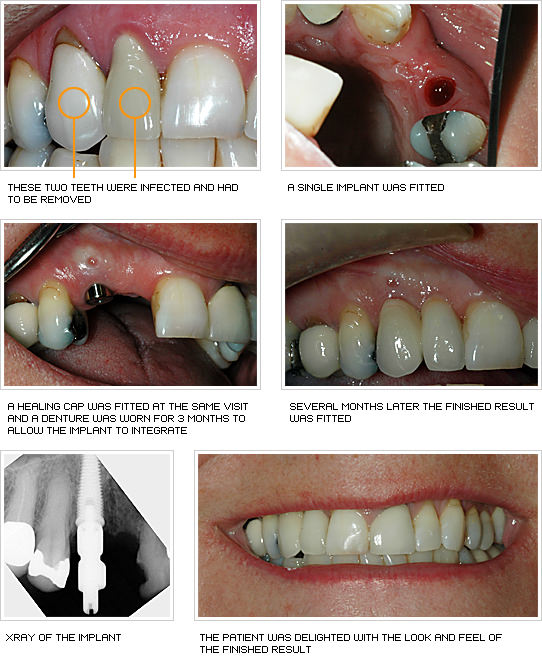Not known Details About Dental Sense
Table of ContentsDental Sense Fundamentals ExplainedDental Sense Can Be Fun For EveryoneExcitement About Dental SenseSome Known Details About Dental Sense
are clinical gadgets operatively dental implanted right into the jaw to restore a person's capacity to chew or their look. They provide support for fabricated (phony) teeth, such as crowns, bridges, or dentures. When a tooth is lost as a result of injury or disease, a person can experience problems such as fast bone loss, faulty speech, or adjustments to chewing patterns that result in discomfort.Dental implant systems contain a dental implant body and oral implant abutment and may likewise consist of an abutment addiction screw. Cosmetic dentistry services. The dental implant body is surgically inserted in the jawbone in place of the tooth's root. The oral implant abutment is usually connected to the dental implant body by the abutment fixation screw and extends with periodontals right into the mouth to support the affixed man-made teeth
(https://writeablog.net/dentalsense1/expert-solutions-for-wisdom-tooth-cavities-and-same-day-dental-implants)Structure of The Oral Implant System selecting oral implants, talk with your oral copyright regarding the potential benefits and risks, and whether you are a candidate for the treatment. Points to think about: Your overall health is an important consider figuring out whether you are a good prospect for oral implants, how long it will take to recover, and how much time the dental implant might remain in area.
Smoking may influence the healing process and lower the long-term success of the dental implant. The healing procedure for the dental implant body may take several months or longer, during which time you usually have a momentary joint instead of the tooth. the dental implant procedure: Carefully follow the oral health instructions provided to you by your dental copyright.
Dental Sense for Beginners
Implant failing can cause the requirement for another surgical procedure to fix or replace the dental implant system. Brings back the capability to chew Restores aesthetic look Helps keep the jawbone from diminishing as a result of bone loss Protects the health of the surrounding bone and periodontals Helps keep surrounding (nearby) teeth stable Boosts lifestyle Damages to surrounding natural teeth during dental implant placement Injury to the surrounding cells throughout surgery, such as sinus perforation Injury during surgical treatment (for instance, crack of bordering jawbone) Poor feature, such as really feeling like the teeth do not attack with each other generally A feeling that the tooth is loosened or twisting in area resulting from a joint screw loosening Implant body failing (looseness of the implant body) as a result of systemic infection, which might be most likely in people with unrestrained diabetes mellitus because of regional infection in bone and gums supporting the dental implant body as a result of postponed healing, which may be much more likely in individuals who smoke Difficulty cleaning up the gum tissues around the implant, leading to bad dental health Unattended gum condition Post-surgical numbness because of nerve impingement or damages Constantly alert healthcare suppliers and imaging professionals that you have oral implants prior to any kind of magnetic vibration imaging (MRI) or x-ray procedures.
FDA is not aware of any type of unfavorable occasions reported for MRI or x-ray treatments with oral implants. Oral implants systems are usually made of products that follow global consensus standards of the International Organization for Standardization (ISO) or ASTM International. These requirements have details of what makes a safe product.

An oral implant is a structure that replaces a missing tooth. With screw-like devices, the doctor inserts an implant into the jawbone, and it functions as a support for an artificial tooth, called a crown. A tool called an abutment attaches the fabricated tooth to the oral implant. The crown is customized to fit the person's mouth and match the color of their teeth.
Fascination About Dental Sense
Some individuals are not eligible for oral implant surgical procedure. It is for dental surgeons to operate individuals with: intense illnessuncontrollable metabolic diseasebone or soft tissue disease or click for source infectionIf these issues are fixed, an individual can have the surgical treatment. In, oral surgeons avoid operating people with: If individuals with any one of the above go through oral implant surgical treatment, there is a higher threat of the implant failing.

Oral implant surgical treatment is an individualized procedure. It's not the very same for everybody. The following gives a basic introduction of what you can anticipate your dental professional, oral doctor, periodontist or prosthodontist to do: Position the implant operatively. Offer you time to recover. Affix the post and last crown, bridge or denture.
Next off, your surgeon will very carefully position the oral implant into your jaw. If your implant is near the front of your mouth, your dentist will certainly make a temporary tooth for you to put on until you heal.
The Of Dental Sense
Your provider can inform you what to anticipate in your circumstance. During the recovery stage, your jawbone must fuse to the dental implant. This procedure, called osseointegration, is vital for security and long-term success. This procedure can take anywhere from 3 to nine months. Sometimes, it might take much longer.
Once your implant heals, your dentist can connect the abutment (tiny port blog post) and your final remediation (crown, bridge or denture). This generally takes regarding one hour to finish and may require a 2nd minor surgery. You should not really feel any type of pain throughout your dental implant procedure since your provider will use medication to numb your periodontals.